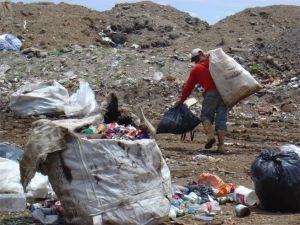Posts Tagged ‘Environment’
Toxic Retail: BPA exposure everywhere
 Retailers aren’t just insulting us by forcing us to make photocopies of receipts we need to save (or watch them fade away), they’re actually poisoning us at the register! And the next time you fill a prescription, ask your Pharmacist about those presciption labels too….
Retailers aren’t just insulting us by forcing us to make photocopies of receipts we need to save (or watch them fade away), they’re actually poisoning us at the register! And the next time you fill a prescription, ask your Pharmacist about those presciption labels too….
Here’s Your Change, Have a Nice BPA Day
PRWatch July, 2010
The Environmental Working Group (EWG) performed laboratory tests on cash register receipts from major U.S. businesses and found bisphenol A (BPA) present on 40% of them, some at levels higher than those found in canned foods, baby bottles and infant formula. BPA is an estrogen-like, plastic-hardening chemical added to many everyday items and that has been linked to breast cancer, heart disease, diabetes and other illnesses. It reacts with dye to form the black or colored print on heat-sensitive paper receipts that millions of people are handed every day while doing business at retail stores. The U.S. Food and Drug Administration had previously declared BPA safe, but announced in January, 2010 that in light of new studies it now has “concerns” about the chemical’s potential effects on brain development of fetuses, infants and children. It stopped short of saying BPA is unsafe. The receipts EWG tested came from businesses in seven states and the District of Columbia, including Safeway, CVS, Whole Foods, Walmart, Chevron, McDonald’s, the U.S. Postal Service and cafeterias in the U.S. Senate and House of Representatives. The American Chemistry Council, which represents the chemical industry, maintains the concerns about exposure to BPA are overblown.
Source: U.S. News and World Report, Science News, July 28, 2010
Written by laudyms
July 28, 2010 at 3:44 pm
Posted in Corporate State, Economics, Environment, Govt folly, Health, Lobbying, Perception Management, Whistleblowers and other heroes
Tagged with BPA, Cancer, Environment, EWG, FDA, Fetal development, Illness, Toxic chemicals
Do Toxins Cause Autism?
 Care2 posted by Melissa Breyer Feb 26, 2010
Care2 posted by Melissa Breyer Feb 26, 2010
It took a few thousand years for us to realize the severity of lead poisoning, although the signs were certainly there: “crazy as a painter” was a catch phrase rooted in the demented behavior of lead-poisoned painters in antiquity. Mad as a hatter? Before the use of mercury was banned in the 1940s, hat makers used it in their craft–which left many of them drooling, twitching, lurching, befuddled and mumbling. Seems to me that when a segment of the population is suffering from a mysterious condition, it would be prudent to examine the possibility of environmental toxins as the culprit.
Lead, mercury, asbestos–can phthalates be next? Phthalates, called “plasticizers,” are a group of industrial chemicals used to make plastics like polyvinyl chloride (PVC) more flexible or resilient and also as solvents. Phthalates, as described by the EWG are nearly ubiquitous in modern society, found in, among other things, toys, food packaging, hoses, raincoats, shower curtains, vinyl flooring, wall coverings, lubricants, adhesives, detergents, nail polish, hair spray and shampoo.
According to a recent story in The New York Times, concern about toxins in our products and the environment used to be a fringe view, but now concern has moved into the medical mainstream. Toxicologists, endocrinologists and oncologists seem to be the most alarmed. One area of particular concern? The relationship between toxins and autism.
Written by laudyms
February 27, 2010 at 7:26 am
Posted in Corporate State, Education, Environment, Food, Agriculture, Globalism, Health, Lobbying, Perception Management, Whistleblowers and other heroes
Tagged with Autism, Brain development, Chemicals, Environment, Phthalates, Safety, Toxix chemicals
History’s greatest Ponzi scheme
 Post Carbon Institute’s Richard Heinberg writes about our ailing economy and alternative solutions in this article: Temporary Recession or the End of Growth?
Post Carbon Institute’s Richard Heinberg writes about our ailing economy and alternative solutions in this article: Temporary Recession or the End of Growth?
“…Given that growth cannot continue on a finite planet, this wager, and its embodiment in the institutions of finance, can be said to constitute history’s greatest Ponzi scheme.
We have justified present borrowing with the irrational belief that perpetual growth is possible, necessary, and inevitable. In effect we have borrowed from future generations so that we could gamble away their capital today.
Until recently, the Peak Oil argument has been framed as a forecast: the inevitable decline in world petroleum production, whenever it occurs, will kill growth. But here is where forecast becomes diagnosis: during the period from 2005 to 2008, energy stopped growing and oil prices rose to record levels. By July of 2008, the price of a barrel of oil was nudging close to $150—half again higher than any previous petroleum price in inflation-adjusted terms—and the global economy was beginning to topple……
……..a good argument can be made that speculation in oil futures was merely magnifying price moves that were inevitable on the basis of the fundamentals of supply and demand……
About 85 percent of our current energy is derived from three primary sources—oil, natural gas, and coal—that are non-renewable, whose price is likely to trend sharply higher over the next years and decades leading to severe shortages, and whose environmental impacts are unacceptable. While these sources historically have had very high economic value, we cannot rely on them in the future; indeed, the longer the transition to alternative energy sources is delayed, the more difficult that transition will be unless some practical mix of alternative energy systems can be identified that will have superior economic and environmental characteristics.”
Written by laudyms
August 31, 2009 at 12:48 pm
Posted in Corporate State, Economics, Energy, Environment, Lobbying, Oligarchy
Tagged with Energy, Energy costs, Environment, Fossil fuels, Growth, Irrational, Ponzi scheme, Renewable energy, Scarcity

